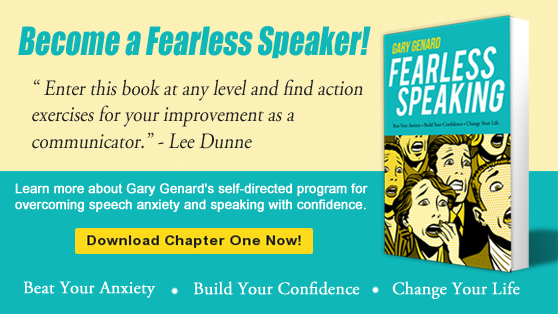
Is speech anxiety a problem for you?
"Glossophobia" is the scientific term. But you may recognize the condition this way: fear of public speaking, stage fright, or speech phobia. If you're a speech professional, you may prefer the term "communication apprehension."
If steadying yourself for a speech or presentation matters to you, there are some key techniques that can help you quickly. To learn how to relax and become a stronger speaker, even when there’s little time to prepare, download my essential cheat sheet, "How to Calm Your Nerves Before Speaking."
How to Reduce Your Stress Level for Public Speaking
Whatever you call this common response to speaking in public, you can certainly recognize its symptoms: anticipatory discomfort, physical activation, situational anxiety, even a panic attack or forgetting to breathe! Yet whether your symptoms are mild or major, you can quickly and easily reduce the nervousness that comes from speech self-consciousness and jitters.
Here are three exercises that will help you shrink your stress levels prior to speaking while boosting your focus and flexibility. Regardless of whether you need 10 ways to stay focused during in-person presentations, or to improve your effectivness in webinars and speaking virtually, these techniques will help get you on your game and keep you there.

(1) Progressive Relaxation: For this exercise, it's best to be lying down on a yoga mat or carpet in a quiet place. You'll probably need about 20 minutes the first time you try this to reach the level of relaxation described. With continued practice, you should be able to cut that time in half.
- Lie on your back, with eyes closed and arms and feet uncrossed at your sides.
- Follow your breath: Be aware of breathing in and out easily. “Watch” the nourishing breath as it becomes part of who you are. Feel how the oxygen nourishes every cell in your body. Become conscious of how refreshing and life-affirming each miraculous breath is.
- Now, as you continue to breathe easily, focus your awareness on the top of your head. Be aware of a sense of complete relaxation. As you focus on that area, your scalp and the individual hairs on your head suddenly release all tension held within them. There's a pleasant sensation, like warm lava melting away all the tension.
- Allow that warm, heavy feeling to flow downward from your scalp to your forehead. Feel the same release of tension and a sensation of smoothness and relaxation.
- Keeping the level of relaxation in your scalp and forehead, let the lava flow down to your eyes. Many of us hold considerable tension behind our eyes. Let it melt away.
- Allow the warm melting-lava feeling to slowly proceed down the rest of your body. Each place it reaches relaxes as the tension melts away. When you get to your fingers, allow any remaining tension to flow out your fingertips. And when you get to your feet, let the same thing happen through your toes. Don’t DO anything; just let it happen.
- Once you're fully relaxed, do a mental scan to locate any remaining pockets of tension. Then let that tension in that spot melt away, until you’re completely and utterly relaxed. Try to remember what this feels like, not in your mind but in your muscle memory.
- Now place your hand on your abdomen where it rises and falls with each breath. Breathe gently and deeply. Feel your hand moving up and down with the “bellows” action? This is what natural breathing in a relaxed state feels like!
When it comes to confidence and credibility, be sure you're broadcasting on the right wavelength! Learn what your body is saying, and how to make your physical presence work for you. Get my e-book "Body Language to Look and Feel Confident."

(2) Diaphragmatic Breathing: Here's another way to develop natural uninhibited breathing.
- Stand with good posture and without tension. Place your dominant hand on your abdomen, where your belly goes in and out with the respiration cycle. That's the area that's controlled by your diaphragm when you breathe.
- Take relaxed deep breaths. On the inhalation, your belly “inflates” outward under your hand; on the exhalation, it returns to its former position. The movement should be easy and effortless. Here's why it's important to learn how to "belly-breathe."
- Be sure you’re not helping your hand. Don’t do anything, just breathe. Your hand will follow the natural movement of the abdominal wall that it’s resting upon.
- There’s no cause for concern if a huge amount of movement isn’t going on down there. If you’re new to diaphragmatic breathing, the action may not be too noticeable at first. The more you practice, however, the easier it will come.
- If you find that you’re breathing "backwards," i.e., if your belly goes in with each inhalation, be patient. Simply observe and begin a new habit of getting the movement occurring in the right direction.
- MIRROR, MIRROR, ON THE WALL: If you stand in front of a mirror, you’ll be able to see the movement more clearly. Stand at an angle that allows you to see your belly slightly in profile. Another helpful technique is to lie in a bath tub filled with warm water. When you inhale, you’ll rise noticeably in the water, just like an inner tube being inflated; and when you exhale, you’ll sink back down. What an enjoyable excuse to take a relaxing bath!

(3) Mini-Vacation: This activity is an excellent continuation of the benefits you gained in either of the above exercises. It also brings your physical senses into play so you can learn to be present even in a stressful speaking situation.
- Lie on your back, with your eyes closed and arms and feet uncrossed at your sides.
- Follow your breath, as in the previous exercises. Allow your body to relish each life-giving, delicious breath. Give yourself over to your breathing. Let it fill your consciousness.
- Focus your awareness on the present time and place: the here-and-now. Think about where you are. Listen to the sounds around you. Smell the air in this room. Become aware of the floor underneath you and the sensation of the air on your skin. Does this place have any taste associated with it? If you opened your eyes, what would you see? (As you can tell, you're activating all your five senses here.) For a few minutes, give yourself over sensually to the present.
- Now imagine that the present moment is dissolving. In its place, take yourself to a favorite location—someplace you love going to. This place now fills your consciousness: a beach on a summer day, a field in springtime, in front of a fire in a ski lodge at the end of a day on the slopes. Wherever you are, this becomes your new reality.
- Open yourself up completely to this special place, experiencing it sensually as you did before: with its sounds, physical sensations, smells, sights, and tastes. Allow your senses to fully populate the world that you’ve recreated.
- Enjoy this place for the next 5 or 10 minutes. Then slowly let it too dissolve as you bring yourself back to the present time and place. But keep the level of deep relaxation and the sensations you’ve achieved. That is, you're in the present, but you’re now experiencing it through all your senses. Let it flood into you and throughout you.
- When you’re ready, open your eyes. While staying completely relaxed, sit up slowly (no need to rush). Relish the sensations of the here-and-now you’re still bathing in.
- Now take this feeling with you as you go about your tasks for the rest of the day. Keep the relaxation of your “mini-vacation” not only in your mind, but in all of your senses and in your physical response to the world around you.
Whatever your level of public speaking nervousness tends to be, these three exercises will boost your physical and mental focus and help keep your anxiety in perspective. They are quick-and-easy resources for coping with the age-old problem of pre-presentation jitters.
This blog was originally published in 2012. It is updated from time to time.
You should follow me on Twitter here.



